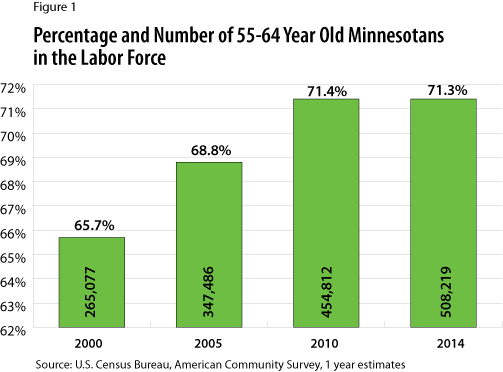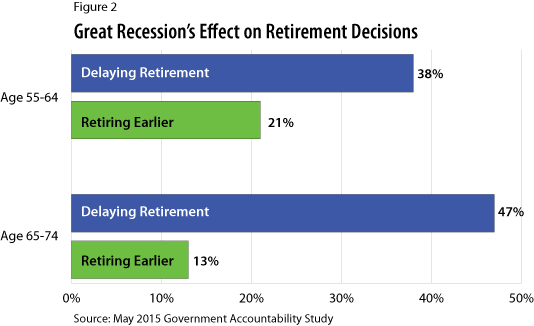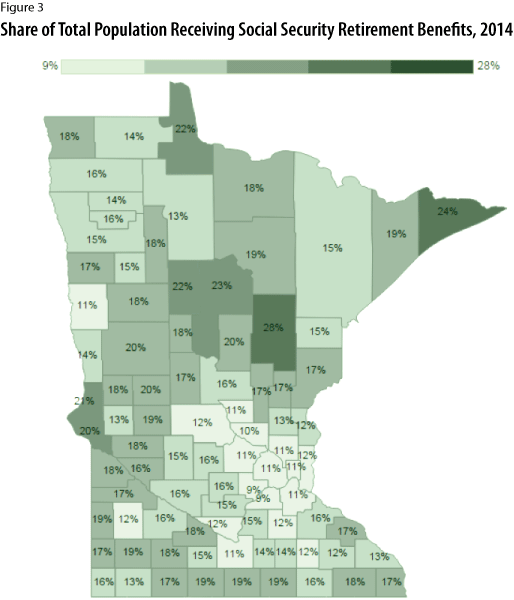by Luke Greiner
April 2016
For years economists and demographers have been predicting an incredible demographic shift in the labor force, both nationally and in Minnesota. Typically attention is drawn to the large generation dubbed "Baby Boomers" or simply "Boomers". This generation is defined as those born between mid-1946 and mid-1964, a longer-than-usual (18 years) period of elevated birthrates following World War II. While our country has experienced higher birth rates, the number of births was unprecedented. The oldest boomers became eligible for full social security retirement benefits (66 years) in 2012, signifying what many predicted as the beginnings of a mass exodus of labor from the workforce (see Table 1).
| Age for Full Retirement Benefit for Retired Workers | |
|---|---|
| Year of Birth | Full Retirement Age (FRA) |
| 1937 and earlier | 65 |
| 1938 | 65 and 2 months |
| 1939 | 65 and 4 months |
| 1940 | 65 and 6 months |
| 1941 | 65 and 8 months |
| 1942 | 65 and 10 months |
| 1943–1954 | 66 |
| 1955 | 66 and 2 months |
| 1956 | 66 and 4 months |
| 1957 | 66 and 6 months |
| 1958 | 66 and 8 months |
| 1959 | 66 and 10 months |
| 1960 and later | 67 |
| Source: Social Security Administration | |
So the question remains, has there been a mass exodus? Are the Baby Boomers retiring in droves as they reach full retirement age, or are they still embracing work? With help from ever increasing medical advances in technology and treatment, Minnesotans enjoy the second longest lifespan in the Union at 81.1 years. Hawaii has the longest expectancy of 81.3 years, and nationally Americans should expect to reach 78.9 years. It is also important to consider the difference between living longer and working longer since poor health conditions or financial state could decrease the number of years individuals are employed even though they live longer.
Many factors beyond turning a certain age affect a senior's ability and willingness to retire. Significant barriers such as a recession, a large medical bill, or lack of personal savings can prohibit a timely entry into the retirement years. Two other reasons that a worker might delay retiring are the emotional and physical satisfaction of self-worth that can be found working. If Baby Boomers began full time work on reaching 18, they likely worked almost 100,000 hours by the time they reach full retirement age. The connection and identification with work is engrained into the very core of many Baby Boomers, who simply refuse to stop being contributing members of the labor force.
Data from the U.S. Census Bureau and Quarterly Workforce Indicators clearly show that we have a larger number of older workers than before, and a previous article examines the industries that employ Minnesota's oldest workers in A Seismic Shift. A significant increase of jobs held by the oldest workers is not surprising since there are simply more of them than in the past relative to other generations.
The percentage of Minnesotans 55-64 years in the labor force has increased from 65.7 percent in 2000 to 71.4 percent by 2010 before dropping slightly to 71.3 percent in 2014. Both the number of the 55-64 year olds and the rate of their participation in the labor force, even if financially obligated, has allowed almost a half million Minnesotan workers on the fringe of retirement to remain employed. If participation rates for 55-64 years olds remained at 2000 levels (65.7 percent) Minnesota would have about 40,000 fewer workers in 2014 (see Figure 1). But it's not just those on the cusp of reaching full retirement age who are remaining in the labor force later in life.

The share of residents 65 years or older participating in the labor force grew even more (23.8 percent) from 14.4 percent in 2000 to 17.3 percent in 2014. At just 2.6 percent in 2014, workers 65 and older also have the lowest incidence of unemployment compared to younger Minnesotans.
According to national data from the Bureau of Labor Statistics, although the proportion of population 65 years and older that was not in the labor force declined from 81.5 percent in 2004 to 77 percent in 2014, the rates have remained higher in Minnesota. In 2005 84 percent of Minnesotans 65 and older were not in the labor force, and by 2014 it was 82.7 percent, 5.7 points higher than the national rate.
At the U.S. level 13.8 percent of 55 to 64 year olds who were not in the labor force cited retirement as the main reason for not working in 2014, down from 15.8 percent in 2004. The percent of the total population 65 years and older not in the labor force because of retirement also decreased from 72.5 percent in 2004, to 68.1 percent in 2014. The next most common reasons cited for not working was being ill or disabled.
The Organization for Economic Cooperation and Development (OECD) provides data on average retirement ages and estimates that from 2004 to 2012 national average effective retirement age increased from 64.2 to 65 years. The long term trend of later retirement ages is certainly a factor in helping explain the increased share of 55- to- 64 year olds in Minnesota's labor force.
A commonly cited explanation for why older workers are delaying retirement or working through retirement is the effect the Great Recession had on savings. While the recession certainly caused many workers to retire later, it also caused some to retire earlier than expected. According to a 2013 GAO Federal Reserve study, 38 percent of people age 55-64 and 47 percent of people 65-74 who had not yet retired reported they delayed retirement since the recession, while 21 percent of people 55-64 and 13 percent of people 65-74 reported they had retired earlier than planned (see Figure 2).

The Government Accountability Office produced a study last year highlighting the limited financial situation of many retirees and workers approaching retirement nationwide. The GAO found that about 29 percent of potential retirees age 55 and older have no retirement plan or defined benefit plan/pension. With personal savings inadequate to fund the Golden Years, "Social Security provides most of the income for about half of households age 65 and older". The Social Security program is incredibly important to many of Minnesota's older population and also the communities in which they live.
With about three in 10 workers 55 and older having no savings beyond their contributions to Social Security nationally, the Government Accountability Office (GAO) estimates that 48 percent households 55 and older will rely on Social Security for most of their retirement income. Even for those with savings, many saved too little since the 48 percent (55+ years) with some retirement savings have a median account value of $109,000, equivalent to an inflated protected annuity of $405 per month for a 65 year old. Older households (65-74 years) aren't in any better shape according to the 2015 GAO report with about 52 percent having no retirement savings.
According to DEED's Cost Of Living tool the minimum monthly cost to live in Minnesota for a single person age 51+ and without children is $2,521. Table 2 details the different major cost categories identified by DEED's Cost Of Living tool. However the cost of living figures include a transportation cost more applicable to someone driving to and from a full-time job. Although many retirees certainly have transportation costs, those costs would most likely be significantly less than the cost in Table 2. Health care is also a major factor that likely has a cost decrease for eligible individuals beginning at age 65 thanks to Medicare although supplemental insurance may be necessary, depending on individual circumstances. Removing the transportation costs from the minimum cost to live still requires a monthly income of $1,878.
| Minimum Cost to Live in Minnesota for Individual Age 51+ Without Children | |
|---|---|
| Food | $324 |
| Health Care | $153 |
| Housing | $701 |
| Transportation | $643 |
| Other | $321 |
| Taxes | $379 |
| Total Monthly Cost | $2,521 |
| Sources: DEED, Cost of Living Tool | |
The average gross monthly Social Security retirement benefit in Minnesota was $1,367.40 for retired workers in December 2014, amounting to an annual benefit of $16,408.90 before taxes. Even as minimum living costs fluctuate depending on life events and circumstances, additional retirement income beyond Social Security helps bridge the gap to ensure basic needs are met.
County level data showing the percentage of retirement benefits largely follows the age profile of each county. With close to 29 percent of the total population 65 years or older, Aitkin County also has the largest share of residents receiving Social Security retirement benefits (27.8 percent), followed by Cook (24.2 percent), and Cass (23.4 percent). Not surprisingly Scott County, with the smallest number of 65 year and older residents in the state, has the lowest share of population receiving Social Security retirement benefits (8.6 percent). A quick glance at Figure 3 shows the pronounced difference between rural and urban centers. The metro- and micropolitan counties across the state have a younger population which translates into a much lower share of their overall population receiving Social Security retirement benefits.
If the national findings about low retirement savings from the Government Accountability Office are true in Minnesota, it's possible that counties with large percentages of their total population drawing Social Security benefits could face changing economic conditions both from losing a larger share of their labor force and from less purchasing power in their communities.

| Social Security Retirement Benefit Statistics, December 2014 | ||
|---|---|---|
| County | Number of Residents Receiving Social Security Retirement Benefits | Per Capita Social Security Retirement Benefits |
| Aitkin | 4,435 | $1,290 |
| Anoka | 37,555 | $1,438 |
| Becker | 5,800 | $1,223 |
| Beltrami | 5,875 | $1,230 |
| Benton | 4,200 | $1,268 |
| Big Stone | 1,055 | $1,138 |
| Blue Earth | 7,395 | $1,306 |
| Brown | 4,465 | $1,259 |
| Carlton | 5,180 | $1,292 |
| Carver | 8,705 | $1,470 |
| Cass | 6,675 | $1,274 |
| Chippewa | 2,010 | $1,213 |
| Chisago | 6,705 | $1,374 |
| Clay | 6,665 | $1,283 |
| Clearwater | 1,545 | $1,119 |
| Cook | 1,260 | $1,311 |
| Cottonwood | 2,075 | $1,229 |
| Crow Wing | 12,305 | $1,311 |
| Dakota | 44,045 | $1,466 |
| Dodge | 2,450 | $1,285 |
| Douglas | 7,190 | $1,262 |
| Faribault | 2,750 | $1,200 |
| Fillmore | 3,680 | $1,198 |
| Freeborn | 5,745 | $1,282 |
| Goodhue | 7,530 | $1,344 |
| Grant | 1,050 | $1,215 |
| Hennepin | 127,445 | $1,483 |
| Houston | 3,195 | $1,261 |
| Hubbard | 4,510 | $1,249 |
| Isanti | 5,015 | $1,350 |
| Itasca | 8,650 | $1,295 |
| Jackson | 1,705 | $1,190 |
| Kanabec | 2,750 | $1,220 |
| Kandiyohi | 6,265 | $1,275 |
| Kittson | 805 | $1,183 |
| Koochiching | 2,345 | $1,310 |
| Lac qui Parle | 1,285 | $1,170 |
| Lake | 2,095 | $1,312 |
| Lake of the Woods | 875 | $1,197 |
| Le Sueur | 4,135 | $1,321 |
| Lincoln | 1,125 | $1,116 |
| Lyon | 3,195 | $1,263 |
| Mahnomen | 835 | $1,099 |
| Marshall | 1,535 | $1,171 |
| Martin | 3,840 | $1,259 |
| McLeod | 5,655 | $1,309 |
| Meeker | 3,645 | $1,255 |
| Mille Lacs | 4,365 | $1,251 |
| Morrison | 5,265 | $1,166 |
| Mower | 6,155 | $1,266 |
| Murray | 1,655 | $1,189 |
| Nicollet | 4,090 | $1,357 |
| Nobles | 2,825 | $1,222 |
| Norman | 1,160 | $1,151 |
| Olmsted | 18,420 | $1,391 |
| Otter Tail | 11,500 | $1,235 |
| Pennington | 1,965 | $1,220 |
| Pine | 4,865 | $1,244 |
| Pipestone | 1,570 | $1,169 |
| Polk | 4,700 | $1,215 |
| Pope | 2,120 | $1,210 |
| Ramsey | 56,570 | $1,441 |
| Red Lake | 660 | $1,135 |
| Redwood | 2,535 | $1,221 |
| Renville | 2,465 | $1,239 |
| Rice | 7,850 | $1,360 |
| Rock | 1,535 | $1,235 |
| Roseau | 2,205 | $1,205 |
| Scott | 11,610 | $1,460 |
| Sherburne | 8,675 | $1,397 |
| Sibley | 2,200 | $1,229 |
| St. Louis | 30,600 | $1,317 |
| Stearns | 18,060 | $1,268 |
| Steele | 5,255 | $1,326 |
| Stevens | 1,250 | $1,227 |
| Swift | 1,685 | $1,192 |
| Todd | 4,180 | $1,174 |
| Traverse | 740 | $1,192 |
| Wabasha | 3,740 | $1,292 |
| Wadena | 2,500 | $1,157 |
| Waseca | 2,730 | $1,277 |
| Washington | 29,060 | $1,473 |
| Watonwan | 1,685 | $1,212 |
| Wilkin | 910 | $1,222 |
| Winona | 6,880 | $1,311 |
| Wright | 13,490 | $1,380 |
| Yellow Medicine | 1,750 | $1,196 |
| Source: Social Security Administration | ||
By state
Boomer ages